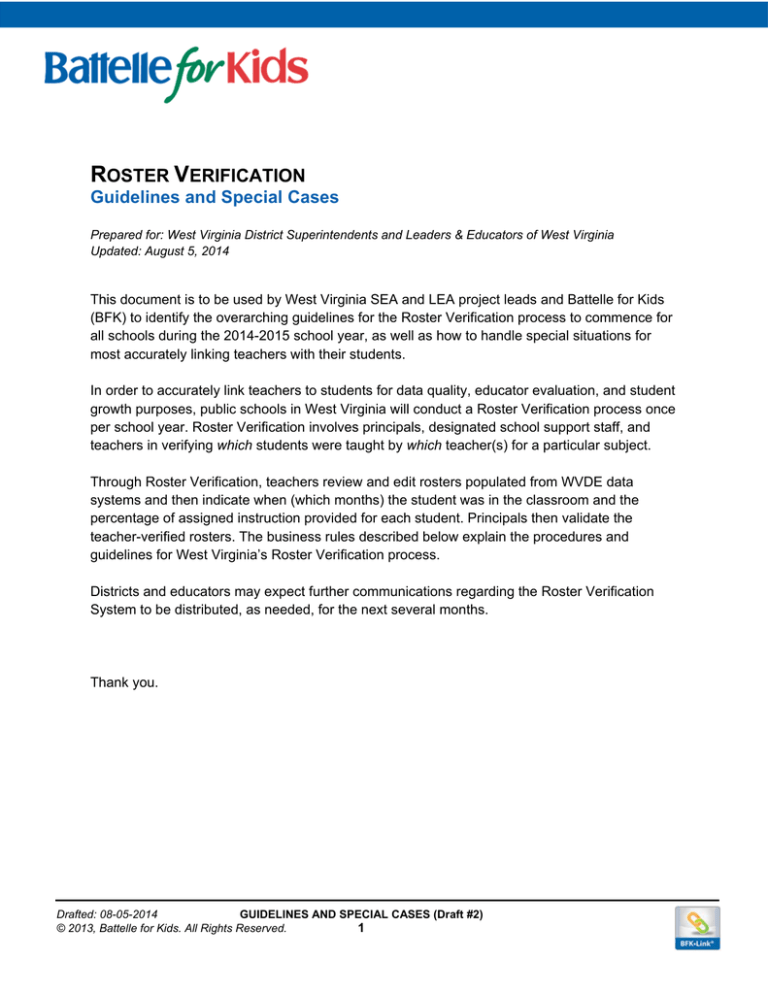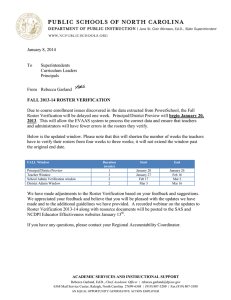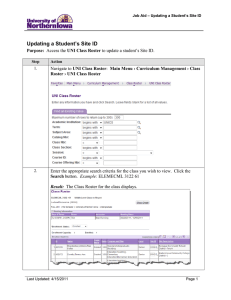R V OSTER
advertisement

ROSTER VERIFICATION Guidelines and Special Cases Prepared for: West Virginia District Superintendents and Leaders & Educators of West Virginia Updated: August 5, 2014 This document is to be used by West Virginia SEA and LEA project leads and Battelle for Kids (BFK) to identify the overarching guidelines for the Roster Verification process to commence for all schools during the 2014-2015 school year, as well as how to handle special situations for most accurately linking teachers with their students. In order to accurately link teachers to students for data quality, educator evaluation, and student growth purposes, public schools in West Virginia will conduct a Roster Verification process once per school year. Roster Verification involves principals, designated school support staff, and teachers in verifying which students were taught by which teacher(s) for a particular subject. Through Roster Verification, teachers review and edit rosters populated from WVDE data systems and then indicate when (which months) the student was in the classroom and the percentage of assigned instruction provided for each student. Principals then validate the teacher-verified rosters. The business rules described below explain the procedures and guidelines for West Virginia’s Roster Verification process. Districts and educators may expect further communications regarding the Roster Verification System to be distributed, as needed, for the next several months. Thank you. Drafted: 08-05-2014 GUIDELINES AND SPECIAL CASES (Draft #2) 1 © 2013, Battelle for Kids. All Rights Reserved. WHAT WILL TEACHERS DO IN ROSTER VERIFICATION? Instructional Attribution Instructional attribution refers to the instructional linkage between a teacher and each student for a particular subject. Through Roster Verification, teachers will verify instructional attribution by confirming: (1) the list of students in a class roster(s), (2) student membership in the class by month, and (3) the percentage of instruction for which they were responsible.* * Note - Student membership and percentage of instruction data collected will ultimately be used to inform relevant components of the Educator Evaluation System. However, Roster Verification is a process for ensuring the accuracy of class roster data for purposes beyond Educator Evaluation. Examples include verifying the students each teacher taught for specific courses over the duration of the academic year, improving Highly Qualified Teacher data, and generally improving the overall quality/reliability of the data utilized by state, district, and school leaders. Roster of Students (Step 1) First, teachers will verify the list of students in a class roster and modify the list by adding and removing students as necessary. We will ask teachers to confirm the roster of students to ensure the data accurately identifies which teacher taught which students for which course. Student Membership (Step 2) Second, teachers will verify student membership in their class by month. A teacher can indicate if a student was not a member of the course for the full academic year (e.g., late enrollment, transfer, early exit). Teachers should claim students for each month the student was a member of the class for the majority of the month. A teacher also can indicate if he or she did not instruct the course for a certain period of the year (e.g., late hire, extended leave). We will ask teachers to confirm student membership to ensure the data accurately identifies the duration of time for which a teacher was responsible for the instruction of a course for specific students. Percentage of Instruction (Step 3) Third, teachers will verify the percentage of instruction for which they were responsible for the given course. Percentage of instruction refers to a teacher’s instructional responsibility for a course. Drafted: 08-05-2014 GUIDELINES AND SPECIAL CASES (Draft #2) © 2013, Battelle for Kids. All Rights Reserved. 2 By requiring teachers to indicate the percentage of instruction through Roster Verification, we are asking them to indicate whether they: a) were fully responsible for the instruction in a given course for specific students, b) shared the instructional responsibility with another teacher(s), or c) played no role in the instruction. Teachers will be asked to indicate the percentage of instruction provided regularly to a classroom of students for a specific scheduled course. WHO PARTICIPATES IN ROSTER VERIFICATION? Participating Individuals All PreK-12 teachers who meet any of the following criteria will participate in Roster Verification: Appear on a school’s Master Schedule Are assigned to and/or are responsible for students and/or teachers Provide instruction to students* Assign grades to students *Per WVDE Policy 2510 & WVDE Policy 5202, Classroom Assistant Teachers and Paraprofessionals do not participate in the roster verification process. All teachers with scheduled classes in the WVEIS will be expected to participate in Roster Verification since we assume the above statement applies to them. In addition, some teachers that do not have scheduled classes in the WVEIS may need to participate if they plan and provide the instruction and assign a grade for a classroom of students (e.g., teachers in a co-teaching arrangement). This includes: PreK-12 general education teachers CTE and OIEP educators Co-teachers (i.e., multiple teachers sharing instructional responsibility) Special education teachers o If a special education teacher plans and provides instruction and assigns a grade for any students, he or she should participate in Roster Verification. Librarians and/or Counselors o If a librarian or counselor plans and provides instruction and assigns a grade for any students (e.g., teaches a reading class), he or she should participate in Roster Verification. Long-term substitutes o If a long-term substitute plans and provides instruction and assigns a grade for any students, he or she should participate in Roster Verification. Drafted: 08-05-2014 GUIDELINES AND SPECIAL CASES (Draft #2) © 2013, Battelle for Kids. All Rights Reserved. 3 This does not include: Classroom Assistant Teachers or Paraprofessionals o They will not participate because they do not plan instruction or assign grades. Student Teachers o Per Policy 5310, the classroom teacher remains Teacher of Record in cases where a student teacher is present. Short Term Substitute Teachers o They will not participate because they do not plan instruction or assign grades. In addition to teachers, school principals and their Support Team members (as designated by the school principal) will participate in the Roster Verification process. Principals will approve teachersubmitted rosters. Support Team members will set up their schools for Roster Verification, help teachers during the process and monitor completion, and prepare verified rosters for principal approval. HOW DOES ROSTER VERIFICATION FUNCTION IN THESE CASES? Treatment of Various Instructional Situations Through Roster Verification, teachers will be asked to model and document the instruction taking place in the classroom. Listed below are several instructional situations which may raise questions for teachers and require clarification for how these situations should be treated. All of these directions relate back to the guiding principles established for Roster Verification. Teachers Who Began Mid-Year (Late Hires) Teachers that assumed responsibility for a classroom mid-year will confirm their class rosters, but will indicate they were not responsible for these students during certain months. Teachers Who Left Mid-Year If a teacher left the school mid-year and was instructing a full year course, the new teacher assigned to the course will complete Roster Verification for that course. This new teacher will reflect the reduced portion of the year for which he or she instructed the course in the membership section. If a teacher left the school mid-year and was instructing a first semester course, this class roster will not be confirmed. In this case, class roster information from the WVEIS system will be used as the default. Itinerant Teachers Itinerant Teachers appearing on a school’s master schedule should appear within the BFK.Link Roster Verification online system at the commencement of the rostering process. Itinerant Teachers who do not appear in the BFK.Link Roster Verification online system at the commencement of the rostering process will need to be added into the system by the school principal or a member of the school’s support team and must be assigned to appropriate course/student rosters. Drafted: 08-05-2014 GUIDELINES AND SPECIAL CASES (Draft #2) © 2013, Battelle for Kids. All Rights Reserved. 4 Co-Teaching Situations Co-teaching describes a situation where multiple teachers share the responsibility of planning and delivering instruction and assigning grades. Teachers in a co-teaching situation will individually verify the class roster. Each teacher should claim the percentage of instruction for the course for which they were responsible. Note, only one teacher will have a schedule for the course in the system. WVDE will be training RESA and district technology personnel on how to create rosters for teachers who are in coteaching situations but are not currently identified within the schedule. School leaders will simply need to copy the class roster and assign it to the other teacher(s). Teachers with Students Who Regularly Attend Classes at an Alternative Learning Center Teachers with students who regularly do not attend their class because they instead attend classes at an Alternative Learning Center should indicate a reduced percentage of instruction for their regular course. For any month a student was not a member of the regular course for the majority of the month, the classroom teacher should document this fact in the membership step of the verification process. Student Attendance Student absences will not be captured through Roster Verification. A student is considered a member of a teacher’s classroom if he or she is enrolled in the course, regardless of absences, and therefore should be accounted for through Roster Verification. For Summative Assessment and Educator Evaluation (Student Growth) purposes - The WVEIS Early Warning System has a default setting of eighteen (18) total absences (or 10% of the total school year) prior to a student being designated as At-Risk. It is recommended that a student exceed a count of twenty-seven (27) total absences in a school year (or 15% of the total school year) prior to considering the exclusion of the student’s State Assessment data (or other relevant growth data) from the Student Growth (15%) component of the educator’s evaluation.* *The West Virginia Department of Education considers this issue a matter of Local Control, and therefore will only provide the above recommendation. The ultimate decision as to whether an individual student’s summative assessment data will be excluded from the Student Growth (15%) component due to high student absenteeism rests solely with leaders at the individual school and district levels. A student’s assessment data cannot be excluded from the School-wide Growth (5%) component of the evaluation. Student Expulsions Student expulsions should be accounted for in the membership step. For any month a student was not a member of the class for the majority of the month due to expulsion, the teacher should document this in the membership step. The teacher should claim the percentage of instruction for which he or she was responsible for instructing the student during the months which the student was a member of the class. Drafted: 08-05-2014 GUIDELINES AND SPECIAL CASES (Draft #2) © 2013, Battelle for Kids. All Rights Reserved. 5 Student Suspensions Suspended students, however, remain enrolled and are still the responsibility of the classroom teacher. Therefore, these students should be fully accounted for in Roster Verification. The fact that a student was suspended during the school year should not be reflected in Roster Verification at all, meaning the teacher should not adjust the membership information (step 2) or the percentage of instruction (step 3). Homebound Instruction Homebound students are not considered to be a member of the teacher’s class roster. Therefore, teachers with a homebound student on their scheduled roster should document this in the membership section, noting the months during which for the majority of the month the student was not a member of their class. The teacher should then claim the percentage of instruction which he or she provided to the student during the time the student was a member of the class. Homeroom or Advisor/Advisee Rosters Homeroom rosters which receive instruction within a content area(s) from the homeroom teacher should have the full roster verification process completed for them. Homeroom rosters which (by design) receive zero instruction from the teacher when convened may be removed from a teacher’s list of rosters to be verified. Roster removal is completed by the school principal during the verification process. OR Homeroom rosters which (by design) receive zero instruction from the teacher when convened may be assigned zero percent instruction by the teacher during the roster verification process. Moderators of Online / Distance Learning Coursework Educators who monitor students completing Online or Distance Learning coursework, however 1) do not plan instruction for those students, AND 2) do not provide instruction to those students, may assign zero percent instruction to the students of such courses during the roster verification process (step 3). Student Attribution / Percentage of Instruction Ideally, all students within a school are claimed for a total of 100% instruction within each course/content area to which they are rostered.However, cases will arise where a student may be claimed for more or less than 100% of instruction within a course/content area. There will be cases where this discrepancy within Percentage of Instruction is not an error or an oversight, but rather an accurate representation of instruction due to the existence of specific variables within the context of the individual school. It is the responsibility of the school principal and support team members to determine when such discrepancies are legitimate, requiring no further action, and when such discrepancies require a resolution within the BFK.Link Roster Verification online system. Drafted: 08-05-2014 GUIDELINES AND SPECIAL CASES (Draft #2) © 2013, Battelle for Kids. All Rights Reserved. 6



